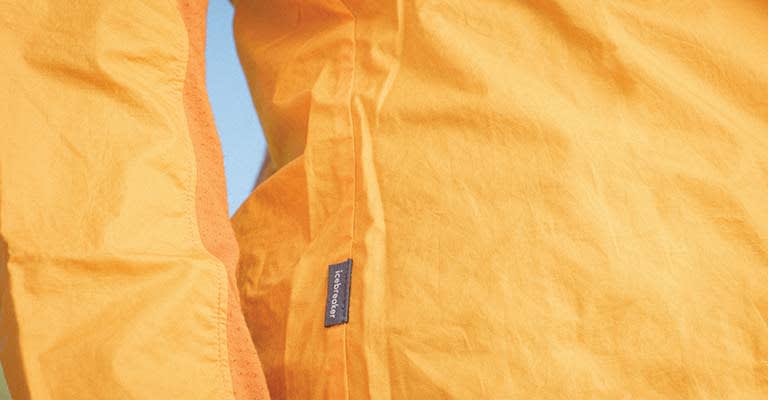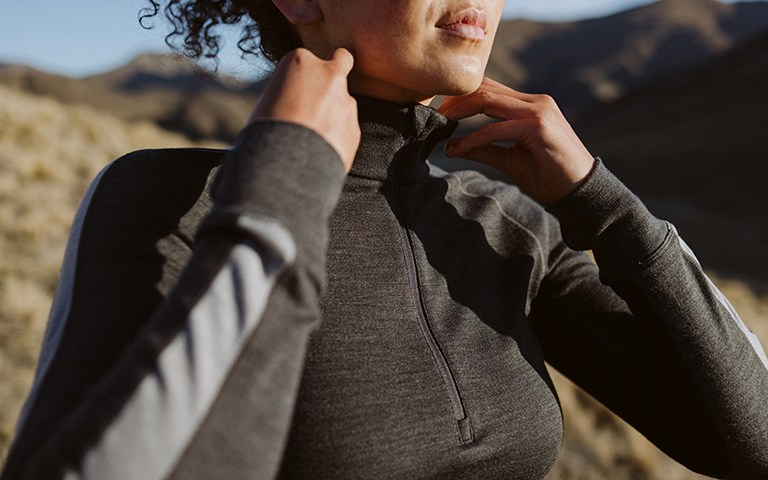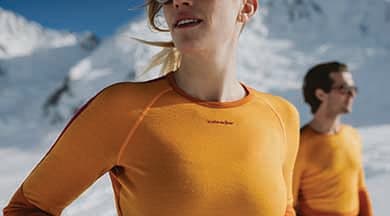Are Natural Fabrics Waterproof?
October 26, 2023 | icebreaker
In this guide, we’ll unpack everything you need to know about staying dry during a sudden cloudburst. First, we’ll discuss the difference between fully waterproof fabric and water-repellent fabrics. Plus, we’ll discover natural fabrics’ ability to resist water. On the way, we’ll look at the many benefits of merino, a naturally water-repellent wool.
What fabric is waterproof?
A fully waterproof fabric is a type of material specially treated or designed to keep you totally dry, no matter how heavy the downpour.
Fully waterproof fabrics may also use chemical, plastic or rubber coatings to help rain bead up and run off. Depending on the application, they can be flexible or more rigid.
Natural fabrics: Water repellent, not waterproof
While not technically fully waterproof, many natural fabrics like merino wool have a secret weapon. That is, they are naturally water-repellent. This means they can resist water to some degree, keeping you fairly dry if the weather suddenly changes. That’s handy in a sudden downpour while you’re out hiking before you can find cover.
Some of the differences between waterproof fabric and water-repellent fabric include:
Water-repellent fabric
Short-term protection - Generally effective against light rain or moisture but not heavy downpours.
Breathability - Water-repellent fabrics are usually more breathable than fully waterproof fabrics.
Lightweight - Often used for everyday wear and activities where heavy protection isn't required.
Limited seam protection - Seams are not always sealed, which can allow water to get in.
Waterproof fabric
Barrier system - Truly waterproof fabrics have an outer layer that prevents any water from penetrating.
Long-term protection - Waterproof fabrics are designed to be effective against heavy downpours and ongoing exposure to water.
Less breathability - Waterproof fabrics can be less breathable than water-repellent fabrics. This can make for clamminess while wearing them, as perspiration can build up inside. However, some breathable waterproof fabric options do exist.
Heavier - Often, durable waterproof fabrics are used for heavy outdoor gear like rain jackets, hiking boots, and tents. The waterproof outdoor fabrics used in these applications tend to be thick, with a rubberized or waxed coating.
Sealed seams - For a garment or piece of outdoor gear to be truly waterproof, its seams are usually sealed. This prevents water from finding its way through the stitching and gaps in the fabric.

Merino: the naturally water-repellent wool
Don’t need full waterproofing but still looking for some protection against the elements? A standout in the world of water-repelling natural fabrics is merino wool.
Not only is merino naturally water repellent but it has a special ability to wick moisture away from the skin. It's like nature's own breathable waterproof fabric. If you get caught in a light drizzle, wearing a merino jacket, beanie or base layers can ensure that you remain relatively dry. Here’s more on what makes it so special:
Lanolin
Merino wool fibers have a natural coating of lanolin. Lanolin acts as a protective barrier, repelling water and preventing the fiber from rapidly soaking up water.
Fiber structure
The outer layer of each merino wool fiber, called the cuticle, is made of tiny overlapping scales. These are hydrophobic (water-repelling). For this reason, water droplets on the surface of merino wool tend to bead up and roll off.
Moisture absorption
The external surface of merino wool repels water. However, the core of the fiber can absorb moisture — up to 30% of its weight without feeling wet to the touch. This means that the wool can take in a certain amount of moisture (like sweat from the body). But in doing so, it doesn't feel wet or clammy, providing comfort to the wearer.
Natural crimp
Merino wool fibers have a natural crimp or wave. This structure creates tiny insulating air pockets. These provide insulation and help to repel liquid water. At the same time, they still allow vapor to pass through.
What is a breathable waterproof fabric?
Simply put, a breathable waterproof fabric is one that doesn't let water in from the outside. Yet, it still allows air and moisture (like sweat) to escape from the inside. This makes sure you're comfortable, not clammy. While merino isn’t a truly waterproof fabric, it does offer some protection against rain. At the same time, it allows the skin to breathe naturally, keeping you comfy.

Merino garments: Dry choices for drizzles
Merino wool isn’t just about sweaters or socks. Thanks to its moisture-wicking properties, there are many merino garments that can help keep you dry and comfortable when it’s damp.
Merino wool base layers
These are perfect for layering underneath your regular clothing, both for every day and keeping active. They trap warmth, wick away sweat, and offer a buffer against light rain, ensuring that you remain dry on the inside.
Merino wool jackets
These are designed specifically for those unpredictable weather moments. They offer a water-repellent surface with the comfort and breathability of natural fibers. While they might not be as waterproof as a heavy-duty rain jacket, merino jackets certainly provide helpful protection.
Merino wool hats and beanies
Headgear made of merino wool is excellent if you want to prevent your head from getting wet in light drizzle.
How to care for natural fabrics
To maximize the life of your natural fabrics, proper care is essential. When it comes to merino garments particularly, good care keeps the fibers in top condition. This in turn helps keep their water repellent nature intact.
Wash with care
Always check the care labels on your garments before throwing them in the wash. Most natural fabrics, like merino, prefer a gentle cycle with mild detergents.
Dry properly
Drying in direct sunlight can cause some fabrics to fade or become blotchy, so always dry in shade. Tumble drying on a low setting is generally okay, but check the drying instructions on your garments.
Store well
Natural fabrics, especially wools, can be targets for pests in certain regions. For this reason, ensure any garments made from natural fabrics are stored in a dry place. Also, consider using natural repellents like cedar balls to keep moths at bay.

Shell+™ innovation
A great choice for those wanting to stay warm and dry while out in the rain, our Shell+™ innovation allows for just that while still incorporating natural fabrics. The range has a natural fiber outer shell which is finished with a water repellent coating to ensure you stay dry. Wind resistant and water repellent these jackets won the Outdoor Retailer Innovation Award in 2022 and are perfect for those looking to explore and stay warm.
The perfect blend of water resistance and breathability
In summary, many natural fabrics like merino wool, while not being a perfect shield against rain, do offer a level of water repellency. They might not fall under the category of fully natural waterproof fabric, however, they do offer a number of other benefits. These include breathability, thermal regulation, moisture-wicking properties and sustainability, among others.
Whether you’re looking for the ultimate Merino wool beanie, Merino thermals, Merino mid layers or a Merino sweater or jacket, we’ve got a vast range of apparel for every climate. Just remember, if you want full protection from heavy downpours, you'll need to opt for specially designed waterproof gear. But for those unpredictable drizzles? Trust in nature's offerings to keep you fairly dry.
More for you

Which fabrics insulate best? | icebreaker
October 27 2022 | icebreaker

How to maintain merino wool | icebreaker
17th August, 2023 | icebreaker

Washing Merino Wool Clothes | Does Merino Shrink? | icebreaker
28 September 2020 | Marie Knowles










